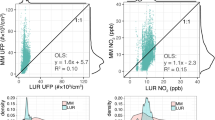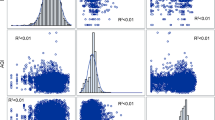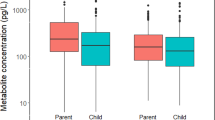Abstract
Association rule mining (ARM) has been widely used to identify associations between various entities in many fields. Although some studies have utilized it to analyze the relationship between chemicals and human health effects, fewer have used this technique to identify and quantify associations between environmental and social stressors. Socio-demographic variables were generated based on U.S. Census tract-level income, race/ethnicity population percentage, education level, and age information from the 2010–2014, 5-Year Summary files in the American Community Survey (ACS) database, and chemical variables were generated by utilizing the 2011 National-Scale Air Toxics Assessment (NATA) census tract-level air pollutant exposure concentration data. Six mobile- and industrial-source pollutants were chosen for analysis, including acetaldehyde, benzene, cyanide, particulate matter components of diesel engine emissions (namely, diesel PM), toluene, and 1,3-butadiene. ARM was then applied to quantify and visualize the associations between the chemical and socio-demographic variables. Census tracts with a high percentage of racial/ethnic minorities and populations with low income tended to have higher estimated chemical exposure concentrations (fourth quartile), especially for diesel PM, 1,3-butadiene, and toluene. In contrast, census tracts with an average population age of 40–50 years, a low percentage of racial/ethnic minorities, and moderate-income levels were more likely to have lower estimated chemical exposure concentrations (first quartile). Unsupervised data mining methods can be used to evaluate potential associations between environmental inequalities and social disparities, while providing support in public health decision-making contexts.
This is a preview of subscription content, access via your institution
Access options
Subscribe to this journal
Receive 6 print issues and online access
$259.00 per year
only $43.17 per issue
Buy this article
- Purchase on Springer Link
- Instant access to full article PDF
Prices may be subject to local taxes which are calculated during checkout

Similar content being viewed by others
References
Callahan MA, Sexton K . If cumulative risk assessment is the answer, what is the question? Environ Health Perspect 2007; 115: 799–806.
U.S. EPA (Environmental Protection Agency). Concepts, Methods and Data Sources for Cumulative Health Risk Assessment of Multiple Chemicals, Exposures and Effects: A Resource Document. U.S. EPA, National Center for Environmental Assessment: Cincinnati, OH, USA. EPA/600/R-06/013F2007.
Taylor WC, Poston WSC, Jones L, Kraft MK . Environmental justice: obesity, physical activity, and healthy eating. J Phys Activity Health 2006; 3: 30–54.
Sexton K, Linder SH . The role of cumulative risk assessment in decisions about environmental justice. Int J Environ Res Public Health 2010; 7: 4037–4049.
Sexton K . Cumulative risk assessment: an overview of methodological approaches for evaluating combined health effects from exposure to multiple environmental stressors. Int J Environ Res Public Health 2012; 9: 370–390.
Sexton K . Cumulative health risk assessment: finding new ideas and escaping from the old ones. Hum Ecol Risk Assess 2014; 21: 934–951.
Alexeeff GV, Faust JB, August LM, Milanes C, Randles K, Zeise L et al. A screening method for assessing cumulative impacts. Int J Environ Res Public Health 2012; 9: 648–659.
Apelberg BJ, Buckley TJ, White RH . Socioeconomic and racial disparities in cancer risk from air toxics in Maryland. Environ Health Perspect 2005; 113: 693–699.
Barzyk TM, White BM, Millard M, Martin M, Perlmutt LD, Harris F et al. Linking socio-economic status, adverse health outcome, and environmental pollution information to develop a set of environmental justice indicators with three case study applications. Environ Justice 2011; 4: 171–177.
Bell ML, Ebisu K . Environmental inequality in exposures to airborne particulate matter components in the United States. Environ Health Perspect 2012; 120: 1699–1704.
Clougherty JE, Levy JI, Kubzansky LD, Ryan PB, Suglia SF, Canner MJ et al. Synergistic effects of traffic-related air pollution and exposure to violence on urban asthma etiology. Environ Health Perspect 2007; 115: 1140–1146.
Cutter SL, Boruff BJ, Shirley WL . Social vulnerability to environmental hazards. Soc Sci Q 2003; 84: 242–261.
Harner J, Warner K, Pierce J, Huber T . Urban environmental justice indices. Prof Geogr 2002; 54: 318–331.
Linder SH, Marko D, Sexton K . Cumulative cancer risk from air pollution in Houston: disparities in risk burden and social disadvantage. Environ Sci Technol 2008; 42: 4312–4322.
Morello-Frosch R, Pastor M, Jr, Porras C, Sadd J . Environmental justice and regional inequality in southern California: implications for future research. Environ Health Perspect 2002; 110: 149–154.
Perlin SA, Sexton K, Wong DW . An examination of race and poverty for populations living near industrial sources of air pollution. J Expo Anal Environ Epidemiol 1998; 9: 29–48.
Sadd JL, Pastor M, Morello-Frosch R, Scoggins J, Jesdale B . Playing it safe: assessing cumulative impact and social vulnerability through an environmental justice screening method in the South Coast Air Basin, California. Int J Environ Res Public Health 2011; 8: 1441–1459.
Sexton K, Linder SH . Cumulative risk assessment for combined health effects from chemical and nonchemical stressors. Am J Public Health 2011; 101 (S1): 81–88.
Chahine T, Schultz BD, Zartarian VG, Xue J, Subramanian SV, Levy JI . Modeling joint exposures and health outcomes for cumulative risk assessment: the case of radon and smoking. Int J Environ Res Public Health 2011; 8: 3688–3711.
Fox MA, J.D. G, Burke TA . Evaluating cumulative risk assessment for environmental justice: a community case study. Environ Health Perspect 2002; 110: 203–209.
Morello-Frosch R, Pastor M, Sadd J . Environmental justice and Southern California’s “Riskscape”: the distribution of air toxics exposures and health risks among diverse communities. Urban Aff Rev 2001; 36: 551–578.
Dawson JF, Richter AW . Probing three-way interactions in moderated multiple regression: development and application of a slope difference test. J Appl Psychol 2006; 91: 917.
Hastie T, Tibshirani R, Friedman J . The Elements of Statistical Learning: Data Mining, Inference and Prediction. Springer, New York, 2005.
Agrawal R, Imieliński T, Swami A . Mining Association Rules Between Sets of Items in Large Databases. ACM SIGMOD, Washington DC, USA, 1993.
Becquet C, Blachon S, Jeudy B, Boulicaut J, Gandrillon O . Strong-association-rule mining for large-scale gene-expression data analysis: a case study on human SAGE data. Genome Biol 2002; 3: 0067.
Chen TJ, Chou LF, Hwang SJ . Application of a data-mining technique to analyze coprescription patterns for antacids in Taiwan. Clin Ther 2003; 25: 2453–2463.
Jiao J, Zhang Y . Product portfolio identification based on association rule mining. Comput Aided Des 2005; 37: 149–172.
Rajak A, Gupta MK . Association Rule Mining-Applications in Various Areas. International Conference on Data Management: Ghaziabad, India, 2008.
Treinen JJ, Thurimella R . A framework for the application of association rule mining in large intrusion detection infrastructures. In: Recent Advances in Intrusion Detection. Springer: Berlin, Heidelberg, Germany. 2006, 1–18.
Bell SM, Edwards SW . Identification and prioritization of relationships between environmental stressors and adverse human health impacts. Environ Health Perspect 2015; 123: 1193–1199.
Bell SM, Edwards SW . Building Associations Between Markers of Environmental Stressors and Adverse Human Health Impacts Using Frequent Itemset Mining. Society for Industrial and Applied Mathematics (SIAM) International Conference on Data Mining, Chicago, Illinois, 2014.
Krieger N, Chen JT, Waterman PD, Soobader MJ, Subramanian SV, Carson R . Geocoding and monitoring of US socioeconomic inequalities in mortality and cancer incidence: does the choice of area-based measure and geographic level matter?: the Public Health Disparities Geocoding Project. Am J Epidemiol 2002; 156: 471–482.
U.S. Census Bureau A Compass for Understanding and Using American Community Survey data: What General Data Users Need to Know. U.S. Government Printing Office: Washington, DC, USA. 2008.
Woodruff TJ, Parker JD, Kyle AD, Schoendorf KC . Disparities in exposure to air pollution during pregnancy. Environ Health Perspect 2003; 111: 942–946.
Padula AM, Mortimer KM, Tager IB, Hammond SK, Lurmann FW, Yang W et al. Traffic-related air pollution and risk of preterm birth in the San Joaquin Valley of California. Ann Epidemiol 2014; 24: 888–95e4.
Kohlhuber M, Mielck A, Weiland SK, Bolte G . Social inequality in perceived environmental exposures in relation to housing conditions in Germany. Environ Res 2006; 101: 246–255.
Sabbath EL, Glymour MM, Berr C, Singh-Manoux A, Zins M, Goldberg M et al. Occupational solvent exposure and cognition: does the association vary by level of education? Neurology 2012; 78: 1754–1760.
U.S. EPA (Environmental Protection Agency EPA’s 2011 National-scale Air Toxics Assessment Technical Support Document. U.S. EPA, Office of Air Quality, Planning, and Standards: Research Triangle Park, NC, USA. 2015.
Habermann M, Souza M, Prado R, Gouveia N . Socioeconomic inequalities and exposure to traffic-related air pollution in the city of Sao Paulo, Brazil. Cad Saude Publica 2014; 30: 119–125.
Thompson U, Caquard S . Compiling a Geographic Database to Study Environmental Injustice in Montréal: Process, Results, and Lessons. Mapping Environmental Issues in the City. Springer: Berlin, Heidelberg, Germany. 2011.
Houston D, Krudysz M, Winer A . Diesel truck traffic in low-income and minority communities adjacent to ports: environmental justice implications of near-roadway land use conflicts. J Transp Res Board 2008; 2076: 38–46.
Brauer M, Lencar C, Tamburic L, Koehoorn M, Demers P, Karr C . A cohort study of traffic related air-pollution impacts on birth outcomes. Environ Health Perspect 2008; 116: 680–686.
Padula AM, Yang W, Carmichael SL, Lurmann F, Balmes J, Hammond SK et al. Air pollution, neighborhood acculturation factors, and neural tube defects among Hispanic women in California. Birth Defects Res 2017; 109: 403–422.
Huang H, Barzyk TM . Connecting the dots: linking environmental justice indicators to daily dose model estimates. Int J Environ Res Public Health 2017; 24.
Hahsler M, Grün B, Hornik K, Buchta C . Introduction to Arules-A Computational Environment for Mining Association Rules and Frequent Item Sets 2009.
Hahsler M, Chelluboina S . Visualizing Association Rules: Introduction to the R-Extension Package arulesViz 2011. https://cran.r-project.org/web/packages/arulesViz/vignettes/arulesViz.pdf.
Borgelt C . Frequent item set mining. Wiley Interdiscip Rev Data Mining Knowl Discov 2012; 2: 437–456.
Ramsey F, Schafer D . The Statistical Sleuth: a Course in Methods of Data Analysis3rd edn.Cengage Learning: Boston, MA, USA. 2012.
Zhang J, Kai FY . What’s the relative risk? A method of correcting the odds ratio in cohort studies of common outcomes. JAMA 1998; 280: 1690–1691.
U.S. Census Bureau. American Community Survey and Puerto Rico Community Survey 2014 Subject Definitions2014. Available from https://www2.census.gov/programs-surveys/acs/tech_docs/subject_definitions/2014_ACSSubjectDefinitions.pdf.
Hillis DM, Bull JJ . An empirical test of bootstrapping as a method for assessing confidence in phylogenetic analysis. Syst Biol 1993; 42: 182–192.
Martínez-Fernández J, Esteve-Selma MA, Calvo-Sendín JF . Environmental and socioeconomic interactions in the evolution of traditional irrigated lands: a dynamic system model. Hum Ecol 2000; 28: 279–299.
Patterson T, Gulden T, Cousins K, Kraev E . Integrating environmental, social and economic systems: a dynamic model of tourism in Dominica. Ecol Model 2004; 175: 121–136.
Kenney MA, Hobbs BF, Mohrig D, Huang H, Nittrouer JA, Kim W et al. Cost analysis of water and sediment diversions to optimize land building in the Mississippi River delta. Water Resour Res 2013; 49: 3388–3405.
Trujillo-Ventura A, Ellis JH . Multiobjective air pollution monitoring network design. Atmos Environ Part A Gen Top 1991; 25: 469–479.
Nau C, Ellis H, Huang H, Schwartz BS, Hirsch A, Bailey-Davis L et al. Exploring the forest instead of the trees: an innovative method for defining obesogenic and obesoprotective environments. Health Place 2015; 35: 136–146.
Huang H, Fava A, Guhr T, Cimbro R, Rosen A, Boin F et al. A methodology for exploring biomarker—phenotype associations: application to flow cytometry data and systemic sclerosis clinical manifestations. BMC Bioinformatics 2015; 16: 293.
Burke TA, Cascio WE, Costa DL, Deener K, Fontaine TD, Fulk FA et al. Rethinking environmental protection: meeting the challenges of a changing world. Environ Health Perspect 2017; 125: 43–49.
Faust J, August L, Bangia K, Galaviz V, Leichty J, Prasad S et al. CalEnviroScreen 3.0 Report. California Environmental Protection Agency, Office of Environmental Health Hazard Assessment: Sacramento, CA, USA. 2017.
Acknowledgements
We thank Dr. Eric S. Hall and Dr. Brandall Ingle for their feedback during the EPA internal review process. This research was supported in part by an appointment to the Postdoctoral Research Program at the U.S. Environmental Protection Agency’s National Exposure Research Laboratory (Research Triangle Park, NC, USA) administered by the Oak Ridge Institute for Science and Education through an Interagency Agreement between the U.S. Department of Energy and the U.S. Environmental Protection Agency. The views expressed in this article are those of the authors and do not necessarily represent the views or policies of the U.S. Environmental Protection Agency.
Author information
Authors and Affiliations
Corresponding author
Ethics declarations
Competing interests
The authors declare no conflict of interest.
Disclaimer
This article has been subjected to review by the EPA and approved for publication. Although this work was performed as research for the U.S. Environmental Protection Agency, it does not necessarily represent endorsement of official Agency policies.
Additional information
Supplementary Information accompanies the paper on the Journal of Exposure Science and Environmental Epidemiology website
Supplementary information
Rights and permissions
About this article
Cite this article
Huang, H., Tornero-Velez, R. & Barzyk, T. Associations between socio-demographic characteristics and chemical concentrations contributing to cumulative exposures in the United States. J Expo Sci Environ Epidemiol 27, 544–550 (2017). https://doi.org/10.1038/jes.2017.15
Received:
Accepted:
Published:
Issue Date:
DOI: https://doi.org/10.1038/jes.2017.15
Keywords
This article is cited by
-
Current practice and recommendations for advancing how human variability and susceptibility are considered in chemical risk assessment
Environmental Health (2023)
-
1,3-Butadiene: a ubiquitous environmental mutagen and its associations with diseases
Genes and Environment (2022)
-
Association mining based approach to analyze COVID-19 response and case growth in the United States
Scientific Reports (2021)
-
Cumulative Risk and Impact Modeling on Environmental Chemical and Social Stressors
Current Environmental Health Reports (2018)



